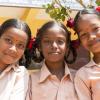
An IIASA study shows that maternal education, and particularly secondary education, plays a significant role in reducing deaths in newborns and children under five years of age in both rural and urban areas of India.
Sustainable Development Goal (SDG) 3.2.1. aims to end preventable deaths of newborns and under-five children by 2030. Although significant progress has been made worldwide in this regard with global under-five deaths falling from 12.5 million in 1990 to 5 million in 2020, it is still a grave concern in many developing countries. This decline is primarily ascribed to improvements in the education of women, along with an increase in living standards and access to healthcare. How the educational attainment level of mothers affects the under-five mortality rate in rural and urban areas has however not been sufficiently explored until now.
In their study recently published in the journal Health & Place, IIASA researchers Moradhvaj and Samir K.C. for the first time explored the relationship between maternal education and children’s health in the rural-urban context in India. Their aim was to find out whether a mother’s educational attainment influences the under-five mortality rate between rural and urban areas in India, and how this has changed over the last three decades. (The under-five mortality rate is the probability of a child dying between birth and its fifth birthday).
“Understanding how education affects under-five mortality is crucial for understanding future population dynamics in developing countries,” notes K.C., who leads the Multidimensional Demographic Modeling Research Group of the IIASA Population and Just Societies Program.
In their study the researchers analyzed five rounds of the Indian National Family Health Survey (NFHS I-V) conducted between 1992 to 1993, and 2019 to 2021. The under-five mortality rate was calculated using data from a questionnaire, which collected detailed information about birth history data among women, especially the date of birth and survival status of each live birth, and the age at death of each deceased live birth. The questionnaire also provided additional information such as age, education, religion, caste, and reproductive behaviors. The data gathered was then fed into a hazard model to analyze predictors of under-five mortality.
The results show that under-five mortality remained higher in rural India across the five study surveys, which may be attributed to poor socioeconomic and healthcare conditions that prevailed there. However, after controlling for socioeconomic and maternal health predictors, the earlier surveys show a higher risk of under-five deaths in urban areas that have converged in recent years, resulting in no significant difference between rural and urban areas. Increasing maternal education, and especially secondary education, was found to reduce the risk of under-five deaths across the surveys.
“In recent years, there have been no significant differences in the under-five mortality rate of children born to mothers with an education level below- or at the primary level, but we know that in the past, the impact of maternal education on mortality differed between rural and urban areas. We found that women with a secondary education living in urban areas, experienced lower child mortality than their rural counterparts with a similar level of education. We did however not find the same effect in the most recent surveys,” explains Moradhvaj, a researcher in the same research group at IIASA.
The researchers conclude that, overall, maternal education, particularly secondary education, remained a protective factor for under-five mortality in both rural and urban areas, even after controlling for predictors.
“While current policies seem to be on the right track, it will be important to increase the educational opportunities in rural and urban areas with a particular focus on secondary education for girls to ensure that we keep up the decline in the under-five mortality rate in both rural and urban areas in India,” K.C. concludes.
Reference
Moradhvaj, M. & K.C., S. (2023). Differential impact of maternal education on under-five mortality in rural and urban India. Health & Place 80 p. 102987 [pure.iiasa.ac.at/18639]
News

20 December 2024
Increase in electric vehicles could create unwanted pollution hotspots

05 November 2024
How ecosystem restoration benefits national policies

12 August 2024


